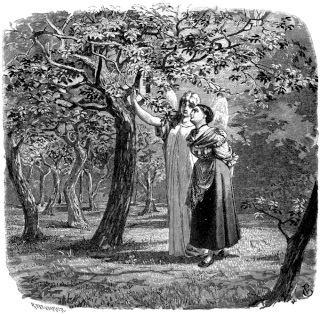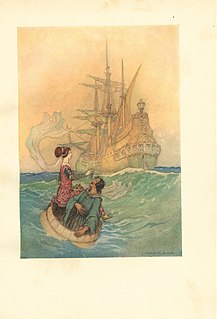Related Research Articles

"Hansel and Gretel" is a German fairy tale collected by the German Brothers Grimm and published in 1812 in Grimm's Fairy Tales. It is also known as Hansel and Grettel, or Little Step Brother and Little Step Sister.

"The Master Maid" is a Norwegian fairy tale collected by Peter Christen Asbjørnsen and Jørgen Moe in their Norske Folkeeventyr. "Master" indicates "superior, skilled." Jørgen Moe wrote the tale down from the storyteller Anne Godlid in Seljord on a short visit in the autumn of 1842. Andrew Lang translated the tale to English and included it in his The Blue Fairy Book (1889). A later translation was made by George Dasent, in his Popular Tales from the North.

The Story of Pretty Goldilocks or The Beauty with Golden Hair is a French literary fairy tale written by Madame d'Aulnoy. Andrew Lang included it in The Blue Fairy Book.

"The Girl Without Hands" or "The Handless Maiden" or "The Girl With Silver Hands" or "The Armless Maiden" is a German fairy tale collected by the Brothers Grimm. It is tale number 31 and was first published in the 1812 edition of Children's and Household Tales. The story was revised by the Grimm brothers over the years, and the final version was published in the 7th edition of Children's and Household Tales in 1857. It is Aarne-Thompson type 706.
"Ferdinand the Faithful and Ferdinand the Unfaithful" is a German fairy tale collected by the Brothers Grimm, tale number 126.
"The Griffin" is a German fairy tale collected by the Brothers Grimm in Grimm's Fairy Tales.

Peruonto is an Italian literary fairy tale written by Giambattista Basile in his 1634 work, the Pentamerone.
The Dove is an Italian literary fairy tale written by Giambattista Basile in his 1634 work, the Pentamerone.
"Corvetto" is an Italian literary fairy tale written by Giambattista Basile in his 1634 work, the "Pentamerone".
The Three May Peaches is a French fairy tale collected by Paul Delarue. He collected more than thirty French types of this tale, which is known in Europe, North Africa, and Asia as far as India.
"King Fortunatus's Golden Wig" is a French fairy tale collected by Colonel A. Troude and G. Milin in Le Conteur breton ou Contes bretons.
Father Roquelaure is a French fairy tale collected by Achille Millien.
The Raven is an Italian literary fairy tale written by Giambattista Basile in his 1634 work, the Pentamerone. The story is a man winning a bride for his brother the king, and then having to protect the couple from perils that he can not tell anyone about, without being turned to stone.
Half-Man is a French fairy tale collected by Achille Millien and Paul Delarue.
La Ramée and the Phantom is a French fairy tale collected by Achille Millien and Paul Delarue.
Little Johnny Sheep-Dung is a French fairy tale collected by Achille Millien and Paul Delarue.
The White Dove is a French fairy tale collected by Gaston Maugard in Contes des Pyrénées.
The Lost Children is a French fairy tale collected by Antoinette Bon in Revue des traditions populaires.
Guerrino and the Savage Man is an Italian literary fairy tale written by Giovanni Francesco Straparola in The Facetious Nights of Straparola.
Georgic and Merlin is a French fairy tale collected by François Cadic in "La Paroisse bretonne".
References
- ↑ Delarue, Paul, ed. (1956). The Borzoi Book of French Folk-Tales (snippet). New York: Alfred A. Knopf, Inc. p. 359.
- ↑ Delarue, Paul, ed. (1947). L'amour des trois oranges et autres contes folkloriques des provinces de France (snippet). Éditions Hier et Aujourd'hui.
- ↑ Delarue, Paul; Ténèze, Marie-Louise, eds. (1997). Le conte populaire français (snippet). Maisonneuve et Larose. p. 200-. ISBN 9782706812774.
- ↑ Paul Delarue, The Borzoi Book of French Folk-Tales, p 359, Alfred A. Knopf, Inc., New York 1956
- ↑ Paul Delarue, The Borzoi Book of French Folk-Tales, p 360, Alfred A. Knopf, Inc., New York 1956